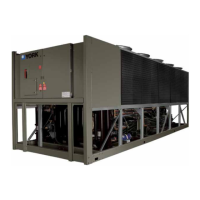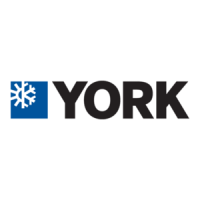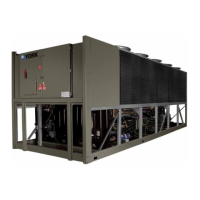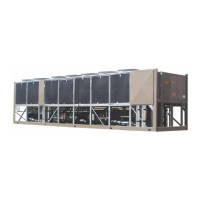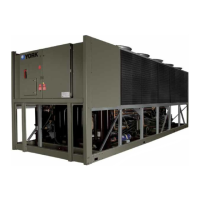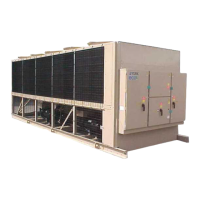INSTALLATION Page: 28 UNIT RIGGING Provides lift points and weight distribution data for the base unit, advising trial lifts for configuration variations.
LOCATION REQUIREMENTS Essential site requirements for optimum performance, including space and air supply for installation.
OUTDOOR INSTALLATIONS Guidelines for installing units at ground level or on rooftops, considering air supply and environmental factors.
INDOOR INSTALLATIONS Recommendations for installing units in enclosed plant rooms, ensuring adequate airflow and proper ducting.
LOCATION CLEARANCES Specifies required clearances for unrestricted airflow, preventing re-circulation, and ensuring maintenance access.
SHIPPING BRACES Notes that the chiller's modular design does not require shipping braces.
CHILLED LIQUID PIPING General recommendations for chilled liquid piping to ensure satisfactory operation and prevent unit damage.
WATER TREATMENT Discusses the impact of water quality, fouling factors, and pH on unit performance and heat exchanger health.
PIPEWORK ARRANGEMENT Provides a suggested piping arrangement for single unit installations, including valve and flow switch locations.
COOLER CONNECTIONS Describes standard chilled liquid connections as Victaulic Groove type and mentions option flanges.
DUCTWORK CONNECTION Recommendations for fan discharge ductwork, including sizing, suspension, and weight support.
ELECTRICAL CONNECTION Provides recommendations for safe and satisfactory unit operation, warning against panel modifications.
POWER SUPPLY WIRING Specifies requirements for the 3-phase power supply, including single point isolation and cable entry.
CONTROL PANEL WIRING Guidance on control wiring, emphasizing shielded cable, grounding, and avoiding electrical noise.
VOLTS FREE CONTACTS Details specifications for voltage-free contacts and inductive load suppression.
Run Contact Explains the function of terminals indicating when a system is running.
Alarm Contacts Details the voltage-free contacts that signal an alarm condition or power failure.
SYSTEM INPUTS Covers inputs like Flow Switch, Remote Run/Stop, and Remote Print for system monitoring and control.
Flow Switch Specifies requirements for a chilled water flow switch to protect against loss of liquid flow.
Remote Run; Stop Describes the input for remote start/stop functionality for system pairs, requiring a dry contact.
Remote Print Explains how to use contacts to trigger a hard copy printout of operating data or fault history.
COMMISSIONING Page: 36 PREPARATION Initial steps for unit commissioning, emphasizing the need for authorized personnel and familiarity with literature.
PREPARATION - GENERAL Basic checks before unit power-up, including electrical lockout/tagout and inspection for installation damage.
Refrigerant Charge Procedure for checking refrigerant pressure, leak testing, and proper charging of the system.
Compressor Oil Guidance on adding oil to the compressor circuit, checking oil levels in separators, and potential issues.
Fans Checks for fan rotation, damage, correct height, and secure fan guards.
Isolation; Protection Verification of single point electrical supply isolation and check of maximum recommended fuse sizes.
Control Panel Check the control panel for foreign materials and ensure it is clean.
Power Connections Ensuring customer power cables are correctly connected to terminal blocks or circuit breakers.
Grounding Verification of the unit's protective ground terminal connection to a suitable grounding point.
Water System Confirming correct chilled liquid system installation, commissioning, and water flow direction.
Flow Switch Verification of a correctly fitted chilled water flow switch wired to the control panel.
Temperature Sensor(s) Ensuring leaving liquid temperature sensor is coated and fully inserted in the water outlet sensor well.
Programmed Options Verifying factory-programmed options match customer order requirements via the OPTIONS Key.
Programmed Settings Ensuring system cutout and operational settings are in accordance with operating requirements via the PROGRAM key.
Date and Time Procedure for programming the date and time using the CLK jumper and DATE/TIME key.
FIRST TIME START-UP Guidance for initial start-up, emphasizing sufficient heat load and proper chiller programming.
Interlocks Verifying liquid flow, heat load, remote run interlocks, and daily schedule for unit operation.
Unit Switch Placing the 'Unit Switch' on the keypad to the ON position to initiate system start-up.
Start-up Procedure for starting systems via the SYSTEM SWITCHES key, with checks for immediate shutdown if issues arise.
Oil Pressure Verifying oil differential pressure develops immediately upon compressor start; immediate shutdown if not.
Refrigerant Flow Checking for liquid refrigerant flow in the sight glass after compressor start and verifying full charge.
Loading Describes automatic unit load adjustment based on chilled liquid temperature and rate of change.
Suction Superheat Checking suction superheat at full load, measuring temps and pressures, and noting programmable setpoints.
Subcooling Checking liquid subcooling at full load, verifying fan operation, and adjusting refrigerant charge as needed.
General Operation Procedure for completing checks for each system, stopping the unit, switching all applicable switches to ON, and restarting.
TECHNICAL DATA Page: 40 WATER PRESSURE DROP Presents a graph showing pressure drop through YCAV evaporators versus water flow rate.
GLYCOL CORRECTION FACTORS Provides correction factors for ethylene and propylene glycol solutions to adjust for pressure drop and flow rate.
ELECTRICAL DATA Presents diagrams for single-point power supply connections with field-supplied circuit protection and optional breakers.
ELECTRICAL NOTES Provides notes on electrical configurations, including NEC codes, conductor types, and unit labels.
LOCATION LABEL Diagram showing fan locations and connections to the VSD/control panel and cooler.
COMPONENT LOCATIONS Illustrations showing the physical locations of major chiller and VSD components.
VSD Logic Board Details the VSD Logic Board's functions, communications, and safeties.
OPERATION Page: 138 OPERATING CONTROLS Details controls such as anti-recycle timer, pump control, heater control, pumpdown, and compressor heater.
Chiller Run Contact Describes the function of the Chiller Run dry contact, indicating system running status.
Unit Switch Explains the function of the ON/OFF rocker switch for the entire chiller and its emergency use.
BASIC OPERATING SEQUENCE Outlines the steps for chiller start-up and loading, including required conditions and compressor staging.
FUZZY LOGIC CONTROL Details how fuzzy logic control makes decisions for speed changes based on error, rate, and temperature.
HOT WATER STARTS Describes loading sequence for hot water starts under 'best' case conditions.
LOAD LIMITING CONTROL Details load limiting controls for preventing safety trips based on parameters like motor current, pressure, and temperature.
ECONOMIZER CONTROL Explains how the Economizer Solenoid controls vapor feed to the compressor for subcooling and system efficiency.
SOUND LIMIT CONTROL Details sound limit control for reducing chiller noise levels at specified times, using local, ISN, or remote setpoints.
MICRO PANEL Overview of the VSD Logic Board's operation, including start/run initiation, PWM generation, and safeties.
VSD SAFETIES (FAULTS) Describes VSD safeties and faults monitored by software and hardware circuitry for protection.
UNIT WARNINGS Explains unit warnings that require operator intervention, such as low battery or microboard issues.
SYSTEM SAFETIES (FAULTS) Details system safeties and faults that cause individual systems to shut down, including ambient temperature faults.
HISTORY KEY Provides access to unit and system operating parameters captured at the time of shutdown or fault.
UNIT DATA KEY Provides displays of unit temperatures, VSD data, and operating hours/start counters.
SYSTEM DATA KEYS 1-4 Offers displays of individual system temperatures, pressures, and operating data.
VSD DATA KEY Provides displays of VSD temperatures, voltages, currents, and other operating data.
SETPOINTS KEY Allows programming of cooling setpoints and ranges, including local, remote, and maximum reset values.
PROGRAM KEY Enables programming of various parameters like suction pressure cutout, ambient temp cutout, and motor current limit.
OPTIONS KEY Allows selection of unit configuration options such as display language, cooling mode, and lead/lag control.
MANUAL OVERRIDE KEY Explains the use of the MANUAL OVERRIDE key for emergencies or servicing, disabling automatic shutdowns.
PRINT KEY Initiates printouts of operating data, history buffers, normal shutdowns, or specific fault data.
UNIT SETUP MODE Allows programming of values that should not be changed by the user, typically set at the factory.
ANALOG INPUT CONNECTIONS Details analog inputs and circuit boards, listing sensors and their corresponding connections and values.
ISN COMMUNICATIONS Explains chiller control board UARTs for RS-485/RS-232, ISN communications, and received data parameters.
ISN TRANSMITTED DATA Details ISN transmitted data for unit, system 1, and system 2, including character types and data values.
ISN FAULT AND INHIBIT CODES Provides fault and inhibit codes with associated meanings, classifying faults by unit or system type and source board.
MAINTENANCE Page: 258 GENERAL REQUIREMENTS Guidelines for continuous operation through regular maintenance, including daily checks and service visits.
Refrigerant Leaks Instructions to visually check heat exchangers, compressors, and pipework for damage and gas leaks.
Operating Conditions Guidance to read operating pressures and temperatures at the control panel within manual limitations.
Compressor Oil Level Procedure to check compressor oil level in the oil separators after the compressor has operated on full load.
Refrigerant Charge Describes observing liquid refrigerant in the sight glass after startup and during stable operation.
Scheduled Maintenance Details operations for minor and major services, recommending intervals and contacting YORK Service Center.
TROUBLESHOOTING GUIDE Guide to diagnose and resolve common problems with the chiller control panel, line fuses, and ambient temperature faults.
EVACUATING A SYSTEM Procedure for evacuating a system to a minimum of 500 microns and checking for leaks.
LIMITED WARRANTY Details warranty terms for new and reconditioned equipment, including exclusions and conditions.
PRINTER WIRING Wiring diagrams for connecting serial printers (Okidata, Seiko, Weightronix) to the chiller.
OPERATING LOG SHEET Forms for logging site and chiller information, programmed values, and programmed cutouts.
SYSTEM OPERATING CONDITIONS Forms for documenting economizer status, valve positions, flash tank level, fan stage, and compressor status.
WATER SYSTEM CONDITIONS Forms for recording evaporator flow rate, pressure drop, glycol freeze point, and condenser air temperatures.
RECOMMENDED SPARE PARTS List of recommended spare parts for YCAV chillers, including model numbers and part numbers.
INSTALLATION Page: 28 UNIT RIGGING Provides lift points and weight distribution data for the base unit, advising trial lifts for configuration variations.
LOCATION REQUIREMENTS Essential site requirements for optimum performance, including space and air supply for installation.
OUTDOOR INSTALLATIONS Guidelines for installing units at ground level or on rooftops, considering air supply and environmental factors.
INDOOR INSTALLATIONS Recommendations for installing units in enclosed plant rooms, ensuring adequate airflow and proper ducting.
LOCATION CLEARANCES Specifies required clearances for unrestricted airflow, preventing re-circulation, and ensuring maintenance access.
SHIPPING BRACES Notes that the chiller's modular design does not require shipping braces.
CHILLED LIQUID PIPING General recommendations for chilled liquid piping to ensure satisfactory operation and prevent unit damage.
WATER TREATMENT Discusses the impact of water quality, fouling factors, and pH on unit performance and heat exchanger health.
PIPEWORK ARRANGEMENT Provides a suggested piping arrangement for single unit installations, including valve and flow switch locations.
COOLER CONNECTIONS Describes standard chilled liquid connections as Victaulic Groove type and mentions option flanges.
DUCTWORK CONNECTION Recommendations for fan discharge ductwork, including sizing, suspension, and weight support.
ELECTRICAL CONNECTION Provides recommendations for safe and satisfactory unit operation, warning against panel modifications.
POWER SUPPLY WIRING Specifies requirements for the 3-phase power supply, including single point isolation and cable entry.
CONTROL PANEL WIRING Guidance on control wiring, emphasizing shielded cable, grounding, and avoiding electrical noise.
VOLTS FREE CONTACTS Details specifications for voltage-free contacts and inductive load suppression.
Run Contact Explains the function of terminals indicating when a system is running.
Alarm Contacts Details the voltage-free contacts that signal an alarm condition or power failure.
SYSTEM INPUTS Covers inputs like Flow Switch, Remote Run/Stop, and Remote Print for system monitoring and control.
Flow Switch Specifies requirements for a chilled water flow switch to protect against loss of liquid flow.
Remote Run; Stop Describes the input for remote start/stop functionality for system pairs, requiring a dry contact.
Remote Print Explains how to use contacts to trigger a hard copy printout of operating data or fault history.
COMMISSIONING Page: 36 PREPARATION Initial steps for unit commissioning, emphasizing the need for authorized personnel and familiarity with literature.
PREPARATION - GENERAL Basic checks before unit power-up, including electrical lockout/tagout and inspection for installation damage.
Refrigerant Charge Procedure for checking refrigerant pressure, leak testing, and proper charging of the system.
Compressor Oil Guidance on adding oil to the compressor circuit, checking oil levels in separators, and potential issues.
Fans Checks for fan rotation, damage, correct height, and secure fan guards.
Isolation; Protection Verification of single point electrical supply isolation and check of maximum recommended fuse sizes.
Control Panel Check the control panel for foreign materials and ensure it is clean.
Power Connections Ensuring customer power cables are correctly connected to terminal blocks or circuit breakers.
Grounding Verification of the unit's protective ground terminal connection to a suitable grounding point.
Water System Confirming correct chilled liquid system installation, commissioning, and water flow direction.
Flow Switch Verification of a correctly fitted chilled water flow switch wired to the control panel.
Temperature Sensor(s) Ensuring leaving liquid temperature sensor is coated and fully inserted in the water outlet sensor well.
Programmed Options Verifying factory-programmed options match customer order requirements via the OPTIONS Key.
Programmed Settings Ensuring system cutout and operational settings are in accordance with operating requirements via the PROGRAM key.
Date and Time Procedure for programming the date and time using the CLK jumper and DATE/TIME key.
FIRST TIME START-UP Guidance for initial start-up, emphasizing sufficient heat load and proper chiller programming.
Interlocks Verifying liquid flow, heat load, remote run interlocks, and daily schedule for unit operation.
Unit Switch Placing the 'Unit Switch' on the keypad to the ON position to initiate system start-up.
Start-up Procedure for starting systems via the SYSTEM SWITCHES key, with checks for immediate shutdown if issues arise.
Oil Pressure Verifying oil differential pressure develops immediately upon compressor start; immediate shutdown if not.
Refrigerant Flow Checking for liquid refrigerant flow in the sight glass after compressor start and verifying full charge.
Loading Describes automatic unit load adjustment based on chilled liquid temperature and rate of change.
Suction Superheat Checking suction superheat at full load, measuring temps and pressures, and noting programmable setpoints.
Subcooling Checking liquid subcooling at full load, verifying fan operation, and adjusting refrigerant charge as needed.
General Operation Procedure for completing checks for each system, stopping the unit, switching all applicable switches to ON, and restarting.
TECHNICAL DATA Page: 40 WATER PRESSURE DROP Presents a graph showing pressure drop through YCAV evaporators versus water flow rate.
GLYCOL CORRECTION FACTORS Provides correction factors for ethylene and propylene glycol solutions to adjust for pressure drop and flow rate.
ELECTRICAL DATA Presents diagrams for single-point power supply connections with field-supplied circuit protection and optional breakers.
ELECTRICAL NOTES Provides notes on electrical configurations, including NEC codes, conductor types, and unit labels.
LOCATION LABEL Diagram showing fan locations and connections to the VSD/control panel and cooler.
COMPONENT LOCATIONS Illustrations showing the physical locations of major chiller and VSD components.
VSD Logic Board Details the VSD Logic Board's functions, communications, and safeties.
OPERATION Page: 138 OPERATING CONTROLS Details controls such as anti-recycle timer, pump control, heater control, pumpdown, and compressor heater.
Chiller Run Contact Describes the function of the Chiller Run dry contact, indicating system running status.
Unit Switch Explains the function of the ON/OFF rocker switch for the entire chiller and its emergency use.
BASIC OPERATING SEQUENCE Outlines the steps for chiller start-up and loading, including required conditions and compressor staging.
FUZZY LOGIC CONTROL Details how fuzzy logic control makes decisions for speed changes based on error, rate, and temperature.
HOT WATER STARTS Describes loading sequence for hot water starts under 'best' case conditions.
LOAD LIMITING CONTROL Details load limiting controls for preventing safety trips based on parameters like motor current, pressure, and temperature.
ECONOMIZER CONTROL Explains how the Economizer Solenoid controls vapor feed to the compressor for subcooling and system efficiency.
SOUND LIMIT CONTROL Details sound limit control for reducing chiller noise levels at specified times, using local, ISN, or remote setpoints.
MICRO PANEL Overview of the VSD Logic Board's operation, including start/run initiation, PWM generation, and safeties.
VSD SAFETIES (FAULTS) Describes VSD safeties and faults monitored by software and hardware circuitry for protection.
UNIT WARNINGS Explains unit warnings that require operator intervention, such as low battery or microboard issues.
SYSTEM SAFETIES (FAULTS) Details system safeties and faults that cause individual systems to shut down, including ambient temperature faults.
HISTORY KEY Provides access to unit and system operating parameters captured at the time of shutdown or fault.
UNIT DATA KEY Provides displays of unit temperatures, VSD data, and operating hours/start counters.
SYSTEM DATA KEYS 1-4 Offers displays of individual system temperatures, pressures, and operating data.
VSD DATA KEY Provides displays of VSD temperatures, voltages, currents, and other operating data.
SETPOINTS KEY Allows programming of cooling setpoints and ranges, including local, remote, and maximum reset values.
PROGRAM KEY Enables programming of various parameters like suction pressure cutout, ambient temp cutout, and motor current limit.
OPTIONS KEY Allows selection of unit configuration options such as display language, cooling mode, and lead/lag control.
MANUAL OVERRIDE KEY Explains the use of the MANUAL OVERRIDE key for emergencies or servicing, disabling automatic shutdowns.
PRINT KEY Initiates printouts of operating data, history buffers, normal shutdowns, or specific fault data.
UNIT SETUP MODE Allows programming of values that should not be changed by the user, typically set at the factory.
ANALOG INPUT CONNECTIONS Details analog inputs and circuit boards, listing sensors and their corresponding connections and values.
ISN COMMUNICATIONS Explains chiller control board UARTs for RS-485/RS-232, ISN communications, and received data parameters.
ISN TRANSMITTED DATA Details ISN transmitted data for unit, system 1, and system 2, including character types and data values.
ISN FAULT AND INHIBIT CODES Provides fault and inhibit codes with associated meanings, classifying faults by unit or system type and source board.
MAINTENANCE Page: 258 GENERAL REQUIREMENTS Guidelines for continuous operation through regular maintenance, including daily checks and service visits.
Refrigerant Leaks Instructions to visually check heat exchangers, compressors, and pipework for damage and gas leaks.
Operating Conditions Guidance to read operating pressures and temperatures at the control panel within manual limitations.
Compressor Oil Level Procedure to check compressor oil level in the oil separators after the compressor has operated on full load.
Refrigerant Charge Describes observing liquid refrigerant in the sight glass after startup and during stable operation.
Scheduled Maintenance Details operations for minor and major services, recommending intervals and contacting YORK Service Center.
TROUBLESHOOTING GUIDE Guide to diagnose and resolve common problems with the chiller control panel, line fuses, and ambient temperature faults.
EVACUATING A SYSTEM Procedure for evacuating a system to a minimum of 500 microns and checking for leaks.
LIMITED WARRANTY Details warranty terms for new and reconditioned equipment, including exclusions and conditions.
PRINTER WIRING Wiring diagrams for connecting serial printers (Okidata, Seiko, Weightronix) to the chiller.
OPERATING LOG SHEET Forms for logging site and chiller information, programmed values, and programmed cutouts.
SYSTEM OPERATING CONDITIONS Forms for documenting economizer status, valve positions, flash tank level, fan stage, and compressor status.
WATER SYSTEM CONDITIONS Forms for recording evaporator flow rate, pressure drop, glycol freeze point, and condenser air temperatures.
RECOMMENDED SPARE PARTS List of recommended spare parts for YCAV chillers, including model numbers and part numbers.
